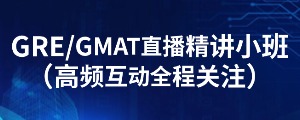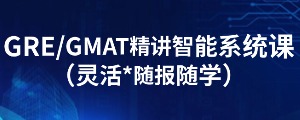选课中心
7099人选课
GMAT公开讲座
0元
GRE公开讲座
0元
一对一体验课
99元
GMAT模考网站
10000人
GRE模考网站
GMAT课程
GRE课程
托福辅导课程
【定制】1v1
私人订制
资料下载
考前冲刺

扫码添加助教
免费领取
备考资料大礼包

扫码关注公众号
新东方在线GMAT频道为大家带来GMAT阅读新题:Passage 17练习题一文,希望对大家GMAT备考有所帮助。更多精彩尽请关注新东方在线GMAT频道!>>点击查看更多GMAT阅读
Passage 17 (17/63)
Prior to 1975, union efforts to organize public-sector clerical workers, most of whom are women, were somewhat limited. The factors favoring unionization drives seem to have been either the presence of large numbers of workers, as in New York City, to make it worth the effort, or the concentration of small numbers in one or two locations, such as a hospital, to make it relatively easy. Receptivity to unionization on the workers’ part was also a consideration, but when there were large numbers involved or the clerical workers were the only unorganized group in a jurisdiction, the multi-occupational unions would often try to organize them regardless of the workers’ initial receptivity. The strategic reasoning was based, first, on the concern that politicians and administrators might play off (to set in opposition for one's own gain从中渔利;在…之间挑拨离间) unionized against non-unionized workers, and, second, on the conviction that a fully unionized public work force meant power, both at the bargaining table and in the legislature. In localities where clerical workers were few in number, were scattered in several workplaces, and expressed no interest in being organized, unions more often than not ignored them in the pre-1975 period.
But since the mid-1970’s, a different strategy has emerged. In 1977, 34 percent of government clerical workers were represented by a labor organization, compared with 46 percent of government professionals, 44 percent of government blue-collar workers, and 41 percent of government service workers. Since then, however, the biggest increases in public-sector unionization have been among clerical workers. Between 1977 and 1980, the number of unionized government workers in blue-collar and service occupations increased only about 1.5 percent, while in the white-collar occupations the increase was 20 percent and among clerical workers in particular, the increase was 22 percent.
What accounts for this upsurge in unionization among clerical workers? First, more women have entered the work force in the past few years, and more of them plan to remain working until retirement age. Consequently, they are probably more concerned than their predecessors were about job security and economic benefits. Also, the women’s movement has succeeded in legitimizing the economic and political activism of women on their own behalf, thereby producing a more positive attitude toward unions. The absence of any comparable increase in unionization among private-sector clerical workers, however, identifies the primary catalyst—the structural change in the multi-occupational public-sector unions themselves. Over the past twenty years, the occupational distribution in these unions has been steadily shifting from predominantly blue-collar to predominantly white-collar. Because there are far more women in white-collar jobs, an increase in the proportion of female members has accompanied the occupational shift and has altered union policy-making in favor of organizing women and addressing women’s issues.
1. According to the passage, the public-sector workers who were most likely to belong to unions in 1977 were
(A) professionals
(B) managers
(C) clerical workers
(D) service workers(A)
(E) blue-collar workers
2. The author cites union efforts to achieve a fully unionized work force (line 13-19) in order to account for why
(A) politicians might try to oppose public-sector union organizing
(B) public-sector unions have recently focused on organizing women
(C) early organizing efforts often focused on areas where there were large numbers of workers
(D) union efforts with regard to public-sector clerical workers increased dramatically after 1975(E)
(E) unions sometimes tried to organize workers regardless of the workers’ initial interest in unionization
3. The author’s claim that, since the mid-1970’s, a new strategy has emerged in the unionization of public-sector clerical workers (line 23) would be strengthened if the author
(A) described more fully the attitudes of clerical workers toward labor unions
(B) compared the organizing strategies employed by private-sector unions with those of public-sector unions
(C) explained why politicians and administrators sometimes oppose unionization of clerical workers
(D) indicated that the number of unionized public-sector clerical workers was increasing even before the mid-1970’s(E)
(E) showed that the factors that favored unionization drives among these workers prior to 1975 have decreased in importance
4. According to the passage, in the period prior to 1975, each of the following considerations helped determine whether a union would attempt to organize a certain group of clerical workers EXCEPT
(A) the number of clerical workers in that group
(B) the number of women among the clerical workers in that group
(C) whether the clerical workers in that area were concentrated in one workplace or scattered over several workplaces
(D) the degree to which the clerical workers in that group were interested in unionization(B)
(E) whether all the other workers in the same jurisdiction as that group of clerical workers were unionized
5. The author states that which of the following is a consequence of the women’s movement of recent years?
(A) An increase in the number of women entering the work force
(B) A structural change in multi-occupational public-sector unions
(C) A more positive attitude on the part of women toward unions
(D) An increase in the proportion of clerical workers that are women(C)
(E) An increase in the number of women in administrative positions
6. The main concern of the passage is to
(A) advocate particular strategies for future efforts to organize certain workers into labor unions
(B) explain differences in the unionized proportions of various groups of public-sector workers
(C) evaluate the effectiveness of certain kinds of labor unions that represent public-sector workers
(D) analyzed and explain an increase in unionization among a certain category of workers(D)
(E) describe and distinguish strategies appropriate to organizing different categories of workers
7. The author implies that if the increase in the number of women in the work force and the impact of the women’s movement were the main causes of the rise in unionization of public-sector clerical workers, then
(A) more women would hold administrative positions in unions
(B) more women who hold political offices would have positive attitudes toward labor unions
(C) there would be an equivalent rise in unionization of private-sector clerical workers
(D) unions would have shown more interest than they have in organizing women(C)
(E) the increase in the number of unionized public-sector clerical workers would have been greater than it has been
8. The author suggests that it would be disadvantageous to a union if
(A) many workers in the locality were not unionized
(B) the union contributed to political campaigns
(C) the union included only public-sector workers
(D) the union included workers from several jurisdictions(A)
(E) the union included members from only a few occupations
9. The author implies that, in comparison with working women today, women working in the years prior to the mid-1970’s showed a greater tendency to
(A) prefer smaller workplaces
(B) express a positive attitude toward labor unions
(C) maximize job security and economic benefits
(D) side with administrators in labor disputes(E)
(E) quit working prior of retirement age
以上就是新东方在线GMAT频道为你带来的GMAT阅读新题练习题,更多精彩敬请关注新东方在线GMAT频道。
| GMAT直播VIP小班 | GMAT直播精讲班 | GMAT录播课 |
| (VIP小班/全科班+1对1) | (全科精讲/单项备考) | (全科班/单项班) |
| 72.5课时 ¥18800 | 61课时 ¥7796 | 134课时 ¥14680 |

 资料下载
资料下载
新东方GMAT佛脚词汇1.0版本
发布时间:2023-06-30添加新东方美研助教号
回复【资料】获取
新东方GMAT数学500题资料下载
发布时间:2023-05-26添加新东方美研助教号
回复【资料】获取
新东方GMAT800题资料下载
发布时间:2022-05-21添加新东方美研助教号
回复【资料】获取
1000句GMAT真实句子改错问题
发布时间:2022-04-17添加新东方美研助教号
回复【资料】获取
2024杨鹏阅读难句(GMAT+GRE)教程
发布时间:2022-04-17添加新东方美研助教号
回复【资料】获取
新东方GMAT数学500题(解析及答案)
发布时间:2019-11-27添加新东方美研助教号
回复【资料】获取
新东方GMAT800题(逻辑+语法+阅读)
发布时间:2019-11-27添加新东方美研助教号
回复【资料】获取
新东方GMAT佛脚词汇1.0版本
发布时间:2019-11-27添加新东方美研助教号
回复【资料】获取
GMAT词汇/长难句/语法资料大全
发布时间:2019-11-27添加新东方美研助教号
回复【资料】获取
GMAT语文考试圣经(Bible)电子版
发布时间:2019-11-27关注新东方在线美研订阅号
回复【GMAT】获取
GMAT推理圣经PDF电子版
发布时间:2019-11-27添加新东方美研助教号
回复【资料】获取
GMAT考试OG五个版本题号对照表
发布时间:2019-11-27添加新东方美研助教号
回复【资料】获取
GMAT Ultimate Grammar电子书籍PDF
发布时间:2019-11-27添加新东方美研助教号
回复【资料】获取

添加美研助教号,
回复【GMAT】获取备考必看资料包

 推荐阅读
推荐阅读
新东方在线GMAT频道为大家带来GMAT阅读复习的五大步骤,希望对大家GMAT备考有所帮助。更多精彩尽请关注新东方在线GMAT频道! 1:原来
新东方在线GMAT频道为大家带来GMAT阅读背景的培养,希望对大家GMAT备考有所帮助。更多精彩尽请关注新东方在线GMAT频道! 一、经济学
新东方在线GMAT频道为大家带来GMAT阅读复习效率不高怎么办,希望对大家GMAT备考有所帮助。更多精彩尽请关注新东方在线GMAT频道! 建
新东方在线GMAT频道为大家带来GMAT阅读提高速度的根本方法,希望对大家GMAT备考有所帮助。更多精彩尽请关注新东方在线GMAT频道! 1
新东方在线GMAT频道为大家带来GMAT阅读如何避免错误,希望对大家GMAT备考有所帮助。更多精彩尽请关注新东方在线GMAT频道! 要避免GMA
新东方在线GMAT频道为大家带来GMAT阅读技巧的提升,希望对大家GMAT备考有所帮助。更多精彩尽请关注新东方在线GMAT频道! GMAT阅读推
新东方在线GMAT频道为大家带来GMAT阅读备考的注意事项,希望对大家GMAT备考有所帮助。更多精彩尽请关注新东方在线GMAT频道! GMAT阅
新东方在线GMAT频道为大家带来GMAT阅读怎么提高自己的能力,希望对大家GMAT备考有所帮助。更多精彩尽请关注新东方在线GMAT频道! 建
新东方在线GMAT频道为大家带来GMAT阅读长句子的备考,希望对大家GMAT备考有所帮助。更多精彩尽请关注新东方在线GMAT频道! 1 首先
新东方在线GMAT频道为大家带来GMAT阅读水平怎么提高,希望对大家GMAT备考有所帮助。更多精彩尽请关注新东方在线GMAT频道! 下面就来


 GRE/GMAT直播精讲小班
GRE/GMAT直播精讲小班
 GRE/GMAT精讲智能系统课
GRE/GMAT精讲智能系统课
 托福直播/精讲课(30天/60天)
托福直播/精讲课(30天/60天)
 资料下载
资料下载
添加新东方美研助教号
回复【资料】获取
添加新东方美研助教号
回复【资料】获取
添加新东方美研助教号
回复【资料】获取
添加新东方美研助教号
回复【资料】获取
添加新东方美研助教号
回复【资料】获取
添加新东方美研助教号
回复【资料】获取
添加新东方美研助教号
回复【资料】获取
添加新东方美研助教号
回复【资料】获取
添加新东方美研助教号
回复【资料】获取
关注新东方在线美研订阅号
回复【GMAT】获取
添加新东方美研助教号
回复【资料】获取
添加新东方美研助教号
回复【资料】获取
添加新东方美研助教号
回复【资料】获取

 阅读排行榜
阅读排行榜
 相关内容
相关内容